Don't wanna be here? Send us removal request.
Photo

1. Bolshoi theatre/ Royal opera house in Covent Garden
2. Russian State library/ British library
3. Pushkin museum of fine arts/ British museum
4. Tretyakov gallery/ National gallery of London
9 notes
·
View notes
Text
Royal opera house in Covent Garden
In December in 1732 in London theatre worker John Rich opened a new Opera house on Covent garden square. Now this theatre is considered to be one of the most visited attractions in London.

During the wars the Opera house performed completely different functions. So, during the First world war, the building "Covent garden" was used as a storage for furniture. During the Second world war - it was a popular dance hall. It was only in 1946 that the «sleeping beauty» ballet was staged at the theatre, and Covent garden acquired its status as the national centre for Opera and ballet.
The theatre was to become a drama theatre, one of two in London in which plays were allowed (the second was «Drury lane»). But over time, Opera and ballet performances began to appear on the stage of the theater more often. Since 1743, during the Easter Fast, it has become a tradition to perform a religious oratorio "Messiah" on the stage of the theatre, this tradition has survived to the present day. The first building of the theater, which existed until 1808, was destroyed by fire. A new building was built next year, and the theatre began its work again. His repertoire at that time was so diverse that it led to a great conflict in the troupe. As a result, half of the actors left the Royal theatre, and it was renamed the Royal Italian Opera in 1847. In 1856, the theater again suffered misfortune – the building was destroyed by fire for the second time.

The Covent garden area in London is a popular place for making films, for example, Alfred Hitchcock made his films here. Covent garden is one of the Central areas of London, the main street of which is Long Acre. Today Covent garden is called the theatre district of London, for the abundance of theatres, including the oldest in the country. The area is also famous for its street performances. In order to perform on the streets of Covent garden, the performer must obtain permission from the authorities, so here you can see only highly professional open-air shows.
В декаб��е 1732 года в Лондоне театральный деятель Джон Рич на площади Ковент-Гарден открыл новый оперный театр. Сейчас этот театр считается одной из самых посещаемых достопримечательностей Лондона.
Примечательно, что во время войн оперный театр выполнял совершенно другие функции. Так в годы Первой мировой войны здание «Ковент-Гардена» использовалось в качестве хранилища для мебели. В течение Второй мировой войны - это был популярный танцевальный зал. Только в 1946 году на сцене театра был поставлен балет «Спящая красавица», и Ковент-Гарден обрел свой статус национального центра оперы и балета.

Театр должен был стать драматическим, одним из двух в Лондоне, в котором разрешалось играть пьесы (вторым был Друри-Лейн). Но со временем на сцене театра все чаще стали появляться оперные и балетные постановки. С 1743 года в дни Пасхального Поста стало традицией исполнять на сцене театра религиозную ораторию «Мессия», эта традиция сохранилась и до наших дней. Первое здание театра, просуществовав до 1808 года, было уничтожено пожаром. А новое здание построено уже в следующем году, и театр снова начал свою работу. Репертуар его в это время был настолько разноплановым, что привел к большому конфликту в труппе, в результате чего половина актеров ушла из Королевского театра, и он был переименован в 1847 году в Королевскую итальянскую оперу. В 1856 году театр опять постигло несчастье – здание было уничтожено пожаром во второй раз.
Район Ковент Гарден в Лондоне является популярным местом для съемок фильмов, например, здесь снимал свои фильмы Альфред Хичкок. Ковент-Гарден – один из центральных районов Лондона, главной улицей которого является Лонг Акр. На сегодняшний день Ковент-Гарден называют театральным районом Лондона, за обилие театров, в том числе старейших в стране. Славиться район и своими уличными представлениями. Для того, чтобы выступить на улицах Ковент-Гарден, исполнитель должен получить разрешение властей, поэтому здесь можно увидеть только высокопрофессиональные шоу под открытым небом.
5 notes
·
View notes
Photo
Holy Family and Donor, 1514, Titian
Medium: oil,canvas

15 notes
·
View notes
Photo
Vincent Van Gogh Series, Sunflowers, 1888-1889
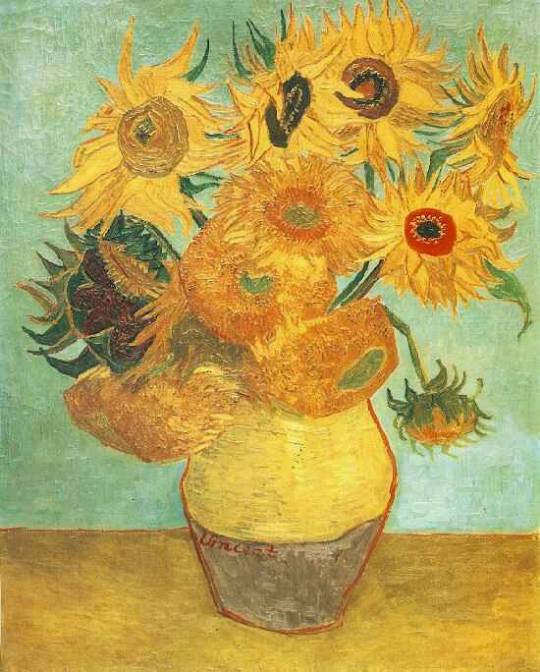
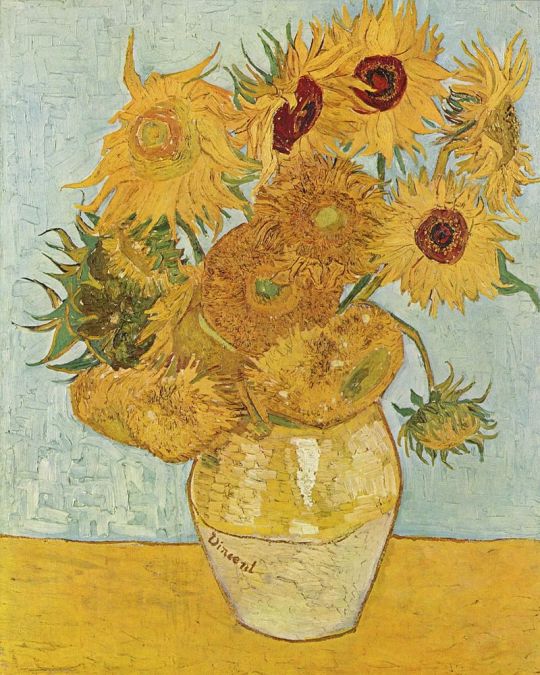
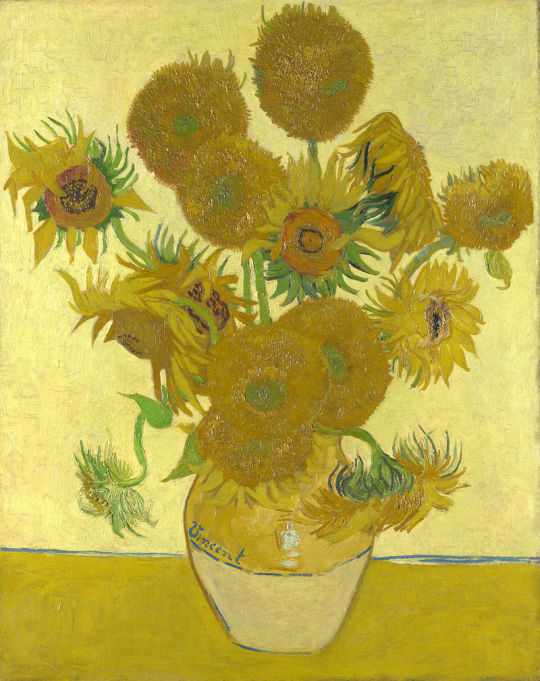
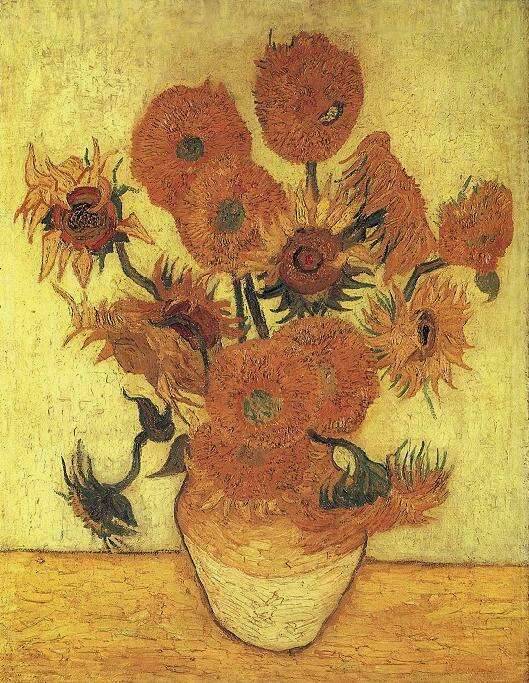
29K notes
·
View notes
Text
London national gallery

It exhibited more than 2,000 masterpieces of painting in Western Europe for the period from the XII to XX centuries. All the paintings in the exhibition are arranged in chronological order. The national gallery of London was established in May in 1824. The basis of the Fund of the future largest exhibition were paintings, formerly owned by a rich banker and a great admirer of painting John Julius Angerstein. After the death of the banker, the British government decided to buy his collection of 38 paintings to prevent the sale of the national heritage at auction. Invaluable contribution was also made by George Beaumont, Holwell-Carr.

The London national gallery is located in the centre of the British capital. Walking around Trafalgar square, you will see a large beautiful building of the National gallery with a dome and columns. While visiting the gallery you will have the opportunity to visually trace how the trends in painting have changed over the centuries, because all the paintings are presented in chronological order. The gallery exhibits a lot of world-famous paintings, including "Venus with a mirror" the works of Velazquez, "the Sunflowers" of van Gogh's pen, "the Holy family" by Titian, "Landscape with castle Walls" of Rubens, the work of Michelangelo's "the Entombment of Christ", Raphael's "Madonna". There is an extensive collection of works by Titian, from the earliest to the latest.
The London gallery plays a significant role not only in the world of painting, but also in the sphere of cinema. Fans of the film "007. Coordinates: "Skyfall" or the series "Sherlock" certainly recognize the London gallery as the location where was the shooting of their favorite paintings.

В ней выставлено более 2000 шедевров живописи Западной Европы за период с XII по XX вв. Все картины в экспозиции расположены в хронологической последовательности. Лондонская Национальная галерея была создана в мае 1824 года. Основу фонда будущей крупнейшей выставки составили полотна, прежде принадлежавшие богатому банкиру и большому поклоннику живописи Джону Джулиусу Ангерштейну. После смерти банкира британским правительством было решено выкупить его коллекцию из 38 полотен, чтобы не допустить продажи с аукциона национального наследия. Бесценный вклад внесли также Джорд�� Бомонт, Холуэлл-Карр.
Лондонская галерея находится в центре британской столицы. Гуляя по Трафальгарской площади, вы сразу же увидите большое красивое здание Национальной галереи с куполом и колоннами. Во время визита в галерею у вас будет возможность наглядно проследить, как менялись тенденции в живописи на протяжении многих веков, ведь все картины здесь представлены в хронологической последовательности. В галерее выставлено множество всемирно известных картин, среди которых «Венера с зеркалом» работы Веласкеса, «Подсолнухи» пера Ван Гога, «Святое семейство» кисти Тициана, «Пейзаж с замком Стен» Рубенса, работа Микеланджело «Погребение Христа», Рафаэля «Мадонна». Здесь имеется обширная коллекция работ Тициана, от ранних до самых последних.
Лондонская галерея играет значимую роль не только в мире живописи, но и в сфере кинематографа. Поклонники фильма «007. Координаты: «Скайфолл» или сериала «Шерлок» наверняка узнают Лондонскую галерею как локацию, где проходили съемки их любимых картин
7 notes
·
View notes
Text
The British library
There are more than 150 million books – from ancient manuscripts, (which are about 2 thousand years old) to modern publications including audio recordings, magazines, maps, prints and more. The treasures that can be found here range from two copies of the 1215 Magna Carta and its first edition in The Times from 1788; from the manuscripts of Leonardo da Vinci to the Bible by Gutenberg; from the Buddhist texts of the Diamond Sutra, one of the world's oldest books, to the manuscript of "Alice in Wonderland" by Lewis Carroll.
The British library dates back to 1753, with a collection of books and manuscripts collected by sir Hans Sloan. The British library was officially established in 1973.
Part of the British library was the famous Reading room of the British Museum. There weresuch famous people as Vladimir Lenin, Mahatma Gandhi, Rudyard Kipling, George Orwell, Herbert wells, Oscar Wilde and many others. The hall was opened after reconstruction in 2000, and now it is a venue for exhibitions.


В Национальной британской библиотеке размещено более 150 миллионов книг – от древних рукописей, возраст которых около 2 тысяч лет до современных изданий¸ включая аудиозаписи, журналы, карты, гравюры и многое другое. Сокровища, которые здесь можно встретить, варьируются от двух копий 1215 года Великой Хартии вольностей и ее первого издания в The Times от 1788; от рукописей Леонардо да Винчи до Библии Гуттенберга; от буддистских текстов Алмазная Сутра, одной из древнейших в мире книг, до рукописи «Алисы в Стране чудес» Льюис�� Кэррола.
Британская библиотека берет свое начало с 1753 года, с коллекции книг и манускриптов, собранной сэром Хансом Слоуном. Официально Британская библиотека была создана в 1973 года.
Частью Британской библиотеки являлся знаменитый Читальный зал Британского музея. В нем за прочтением книг сиживали такие известные люди, как Владимир Ленин, Махатма Ганди, Редьярд Киплинг, Джордж Оруэлл, Герберт Уэллс, Оскар Уайльд и многие другие. Зал открылся после реконструкции в 2000 году, и теперь является местом проведения выставок.
11 notes
·
View notes
Photo

Black-figure neck-amphora with Odysseus and companions blinding Polyphemus, attributed to the Polyphemus Group
Greek (produced in Italy in the Chalcidian style), Archaic Period, 520 B.C.
terracotta
British Museum
244 notes
·
View notes
Photo
Brooches from the Penrith Hoard, now in the British Museum. Tag on exhibit states: The Penrith Hoard, Early 10th Century AD. From Fluskew Pike, Newbiggin, near Penrith, Cumbria. Brooches from a hoard of at least seven silver brooches of Irish Viking type. The two largest were found in 1785 and 1830. The others, found in 1990, show severe damage from poughing. One is inscribed with the Viking runic alphabet, or futhark, perhaps to bring good luck to the wearer.

432 notes
·
View notes
Text
British Museum

The history of the Museum is amazing. It was founded not by a philanthropist and not an artist, but by a scientist - naturalist royal life-doctor sir Hans Sloan, who bequeathed to the state his huge collection of ethnographic and natural-scientific rarities.
Appearance of the museum: huge facade with columns. It reminds of the Pushkin Museum of fine arts in Moscow. But the British museum is much bigger.
The Museum is really huge! It is called one of the treasures of the world and the Museum of civilizations, because here, in buildings erected more than a hundred years, you can find exhibits of any of the world's famous cultures. You can't see all the museum expositions in a day. In the Museum you can find items which were found during excavations.
The British Museum is the second most visited art Museum in the world after the Louvre. The Museum's collection covers 2 million years of human history.
In 2005, the famous street artist Banksy secretly placed in the British Museum painting, which depicted a caveman pushing a cart from a supermarket. The Museum staff found and removed the canvas only a few days later, not realizing that the picture is not included in the exhibition. In 2004, a visitor stole earrings and other jewelry from the British Museum, Dating back to 700 AD, simply carrying them on. And in 2002 thieves managed to steal from the Greek gallery the head from marble.

История возникновения музея вызывает уважение. Он был основан не меценатом и не деятелем искусства, а учёным - натуралистом королевским лейб-медиком сэром Хансом Слоуном, завещавшим государству свою гигантскую коллекцию этнографических и естественно-научных редкостей.
Внешний вид: огромный фасад с колоннами. Напоминает московский Пушкинский музей. Только Британский кажется значительно бОльшим.
Музей действительно огромен! Его называют одной из сокровищниц мира и музеем цивилизаций, ведь здесь, в зданиях, возводимых более ста лет, можно найти экспонаты любой из известных мировых культур. За день его точно не осмотреть. В музее можно найти предметы, найденные при раскопках.
Британский музей. Британский музей — второй по посещаемости художественный музей в мире после Лувра. Коллекция музея охватывает 2 млн лет человеческой истории.
В 2005 году известный уличный художник Бэнкси тайком разместил в Британском музее картину, на которой был изображен пещерный человек, толкающий тележку из супермаркета. Сотрудники музея обнаружили и сняли полотно только спустя несколько дней, не поняв, что картина не входит в экспозицию. Не обошлось и без краж в этом музее. В 2004 году посетительница украла из Британского музея серьги и другие драгоценности, датируемые 700 годом н.э., просто вынеся их на себе. А в 2002 году ворам удалось украсть из Греческой галереи голову из мрамора.
5 notes
·
View notes
Photo

2K notes
·
View notes
Text

I like learning English, so I'm interested in everything related to England. London is the capital and symbol of Great Britain. Every year this city is visited by a large number of people. Why do so many people aspire to London? Are they interested in the culture of the city? These questions made me want to know more about this city. I have prepared a short route which consists of places such as the British Museum (image 1), the national gallery of London (image 2), the British library (image 3), the Royal Opera house in Covent garden (image 4).
-----------------------------------------------------------------------------------------------------------
Я люблю изучать английский язык, поэтому мне интересно все, что связано с Англией. Лондон – столица и символ Великобритании. Каждый год этот город посещает большое количество человек. Почему так много людей стремятся в Лондон? Заинтересованы они культурой города? Эти вопросы вызвали у меня желание узнать больше об этом городе. Я подготовила небольшой маршрут, состоящий из таких мест, как Британский музей (изображение под цифрой 1), Лондонская Национальная галерея (2), Британская библиотека (3), Королевский театр оперы в Ковент-Гардене (4).
1 note
·
View note
Text
Have you ever thought that the Bolshoi theatre is a kind of "a state within a state", that it is a special world with its own laws, traditions and hierarchy? It is difficult to put into words all the magnificence that appeared to our eyes. The great columns, majestic walls allow us to see the theatre in all its true Imperial brilliance. Surprisingly, below the theatre there are 6 more underground floors; under the roof there is a brand new rehearsal room with a luxurious hall made of dark wood, where artists relax in anticipation of their party and where there is no access to the outsiders.

Вам когда-нибудь приходило в голову, что Большой театр – это своего рода «государство в государстве», что это особый мир со своими законами, традициями, своей иерархией? Сложно передать словами всё великолепие, которое предстало нашим глазам. Грандиозные колонны, величественные стены позволяют нам увидеть театр во всем своём истинно императорском великолепии.Удивительно, что внизу под театром находятся ещё 6 подземных этажей; под крышей есть новенький репетиционный зал с роскошным залом из темного дерева, где отдыхают артисты в ожидании своей партии и куда нет доступа посторонним.

6 notes
·
View notes
Text
Pushkin Museum of Fine Arts

Pushkin museum has one of the greatest (after the Hermitage) collection of foreign art. I was able to visit here more than once, and I can say that it is quite a cozy and pleasant place which can leave a nice impression. The museum includes ancient monuments, paintings by Rembrandt, Claude Monet, Degas, van Gogh, Picasso etc.
The Museum changed its name twice. Firstly it was opened as the Museum of fine arts named after Emperor Alexander III at the Imperial Moscow University. Then in 1932 it became the State Museum of fine arts. And five years later, in connection with the century since the death of Alexander Pushkin, it was given the name of the poet.
One of the most mysterious and interesting facts is that the famous "Gioconda" was brought in the museum. In 1974 in Pushkin exhibited the legendary "Gioconda" by Leonardo Da Vinci and this was the last time the picture left the Louvre to go abroad. Then 300 thousand people came to see the masterpiece. However, this is not the limit — the record of Museum attendance was recorded seven years later.
The Museum's collections were evacuated for three years. In wartime, from 1941 to 1944, the paintings of the Pushkin Museum were taken to Novosibirsk and Solikamsk, so that they were not affected by the bombing. But this fate could not be avoided by the building itself-during air raids, it lost part of the roof. Still in some places there is a trace of fragments of German bombs, for example, in the upper part of the Western facade of the Museum, from the Small Znamensky lane.

-Pushkin museum during the Great Patriotic war (World War II)
5 notes
·
View notes
Photo

Monument to Dostoevsky in front of Russian State Library, Moscow
15 notes
·
View notes
Photo

Reading room in the Russian State Library in Moscow
Quick poll: who else loves libraries?!
190 notes
·
View notes
Text
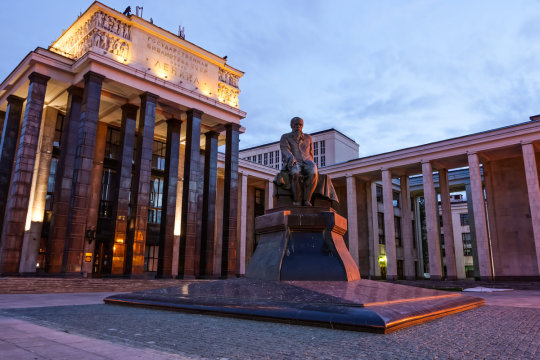
Within the walls of the Russian State library you can see a unique collection of native and foreign documents. In order to get to the library you need to have a library card, which will take no more than 10 minutes.
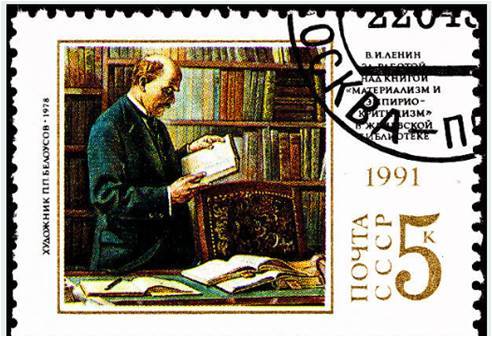
The Russian state library is the national library of the Russian Federation, the largest public library in Russia and continental Europe and one of the largest libraries in the world. It is the leading research institution in the field of library science, bibliography and bibliology. Now there are more than 47 million books, documents and artifacts. More than 800 thousand people visit the library every year.
В стенах Российской государственной библиотеки (Библиотеки им. Ленина) находится ун��кальное собрание отечественных и зарубежных документов. Для того, чтобы попасть в библиотеку необходимо иметь читательский билет, на получение которого потребуется не более 10 минут.
Российская государственная библиотека — национальная библиотека Российской Федерации, крупнейшая публичная библиотека в России и континентальной Европе и одна из крупнейших библиотек мира. Ведущее научно-исследовательское учреждение в области библиотековедения, библиографии и книговедения. Сейчас здесь хранится более 47 миллионов книг, документов и артефактов. В год библиотеку посещает больше 800 тысяч человек
5 notes
·
View notes
Text

The State Tretyakov Gallery is one of Russia’s largest art galleries. In contrast to the Pushkin Museum of Fine, with its extensive collection of foreign art, the Tretyakov Gallery mainly exhibits classical Russian art – paintings, sculptures, icons etc. The Tretyakov Gallery actually consists of two separate buildings. The opening of the museum in the second half of the 19th century was a truly significant event in the cultural life of Russia. Pavel Tretyakov was not only a successful entrepreneur but also a collector with exquisite artistic taste. Tretyakov wrote: “I do not need glorious nature or a perfect composition, no miracles. Give me a dirty puddle, only the one that is true poetry. Poetry can be everywhere; it is the artist’s business”. On may 22, 2016, the State Tretyakov Gallery celebrated the 160th anniversary of its Foundation.

Государственная Третьяковская галерея - одна из крупнейших художественных галерей России. В отличие от музея изобразительных искусств им. Пушкина, его обширной коллекцией зарубежного искусс��ва, Третьяковская галерея в основном экспонирует классическое русское искусство – живопись, скульптуру, иконы и др. Третьяковская галерея фактически состоит из двух отдельных зданий. Открытие музея во второй половине 19 века стало поистине знаменательным событием в культурной жизни России. Павел Третьяков был не только успешным предпринимателем, но и коллекционером с изысканным художественным вкусом. Третьяков писал: “Мне не нужна ни славная природа, ни совершенная композиция, ни чудеса. Дайте мне грязную лужу, только ту, что настоящая поэзия. Поэзия может быть везде, это дело художника”.22 мая 2016 года Государственная Третьяковская галерея отметила юбилей (160 лет со дня основания).
9 notes
·
View notes